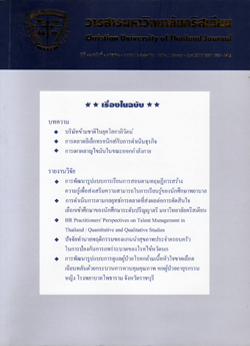การเผาผลาญไขมันในขณะออกกำลังกาย
บทคัดย่อ
ไขมันในร่างกายเป็นปัจจัยเสี่ยงของโรคร้ายต่างๆ และปัญหาด้านจิตใจและสังคม มีการศึกษาวิธีการออกกำลังกายเพื่อจำกัดไขมันในร่างกายให้ได้มากที่สุด พบว่าไขมันจะถูกเผาผลาญไปเป็นพลังงานมากที่สุดในการออกกำลังกายอย่างเบา (Low-intensity exercise) หรือที่ระดับหัวใจเต้นร้อยละ 40 ของอัตราเต้นของหัวใจสูงสุด หากต้องการเผาผลาญไขมันให้ได้มากที่สุดระหว่างการออกกำลังกายแบบ แอโรบิค (Aerobic exercise) ต้องฝึกที่ระดับความหนักต่ำกว่าจุดวิกฤติของกรดแลคเตท (Lactate threshold, (LT)) หรือให้หัวใจเต้นร้อยละ 70-75 และ 80-90 ของอัตราการเต้นหัวใจสูงสุดในคนที่ไม่ค่อยได้ออกกำลังกาย และในคนที่ออกกำลังกายเป็นประจำ ตามลำดับ การออกกำลังแบบมีแรงต้านอย่างหนักก่อนการฝึกแบบแอโรบิค จะทำให้เกิดการใช้ไขมันในขณะออกกำลังกายแบบแอโรบิคมากขึ้นเป็นทวีคูณ เนื่องจากการออกกำลังแบบมีแรงต้านอย่างหนักทำให้เกิดภาวะพร่องไกลโคเจน จึงเหลือแหล่งพลังงานเดียวคือ ไขมัน อย่างไรก็ตาม การออกกำลังกายในลักษณะดังกล่าว ไม่เหมาะสมกับนักกีฬา เพราะอาจทำให้กล้ามเนื้อล้า ส่งผลให้ประสิทธิภาพของการแข่งขันอาจน้อยลงได้
เอกสารอ้างอิง
Achten J, Gleeson M, Jeukendrup AE.(2002). Determination of the exercise intensity that elicits maximal fat oxidation. Med Sci Sports Exerc, 34 (1), 92-97.
Bassami M, Ahmadizad S, Doran D, Maclaren DP. (2007). Effects of exercise intensity and duration on fat metabolism in trained and untrained older males. Eur J Appl Physiol,101 (4), 525-532.
Bonen A, Dohm GL, van Loon LJ.(2006). Lipid metabolism, exercise and insulin action.Essays Biochem, 42 (1), 47-59.
Coyle EF, Jeukendrup AE, Wagenmakers AJ, Saris WH. (1997). Fatty acid oxidation is directly regulated by carbohydrate metabolism during exercise. Am J Physiol, 273 (2 Pt 1), E268-275.
Fulton JE, Mโsse LC, Tortolero SR, Watson KB, Heesch KC, Kohl HW 3rd, Blair SN, Caspersen CJ.(2001). Field evaluation of energy expenditure from continuous and intermittent walking in women. Med Sci Sports Exerc,33 (1), 163-170.
Gunderson H, Wehmeyer N, Burnett D, Nauman J, Hartzell C, Savage S.(1996). Exercise and exhaustion effects on glycogen synthesis pathways. J Appl Physiol, 81(5), 2020-2026.
Gunn SM, Brooks AG, Withers RT, Gore CJ, Owen N, Booth ML, Bauman AE.(2002). Determining energy expenditure during some household and garden tasks. Med Sci Sports Exerc,34(5), 895-902.
Hไkkinen K, Kraemer WJ, Pakarinen A, Triplett-McBride T, McBride JM, Hไkkinen A, Alen M, McGuigan MR, Bronks R, Newton RU. (2002). Effects of heavy resistance/power training on maximal strength, muscle morphology, and hormonal response patterns in 60-75-year-old men and women. Can J Appl Physiol, 27 (3), 213-231.
Klein S, Coyle EF, Wolfe RR.(1994). Fat metabolism during low-intensity exercise in endurance-trained and untrained men. Am J Physiol, 267 (6 Pt 1), E934-940.
LeMura LM, Maziekas MT.(2002) Factors that alter body fat, body mass, and fat-free mass in pediatric obesity. Med Sci Sports Exerc, 34 (3), 487-496.
Martin WH.(1997). Effect of endurance training on fatty acid metabolism during whole body exercise. Med Sci Sports Exerc, 29 (5), 635-639.
Melanson EL, Sharp TA, Seagle HM, Horton TJ, Donahoo WT, Grunwald GK, Hamilton JT, Hill JO. (2002). Effect of exercise intensity on 24-h energy expenditure and nutrient oxidation. J Appl Physiol, 92(3), 1045-1052.
Michael W. King (2001). Mobilization of fat store: Medical Biochemistry. http://themedicalbiochemistrypage.org/fatty-acid-oxidation.html. Retrieved on October1, 2008.
Mulla NA, Simonsen L, Bulow J. (2000). Post-exercise adipose tissue and skeletal muscle lipid metabolism in humans: the effects of exercise intensity. J Physiol, 524(1),919-928.
Newton RU, Hakkinen K, Hakkinen A, McCormick M, Volek J, Kraemer WJ. (2002). Mixed-methods resistance training increases power and strength of young and older men. Med Sci Sports Exerc,34(8), 1367-1375.
Ormsbee MJ, Thyfault JP, Johnson EA, Kraus RM, Choi MD, Hickner RC. (2007). Fat metabolism and acute resistance exercise in trained men. J Appl Physiol, 102(5),1767-1772.
Romijn JA, Coyle EF, Sidossis LS, Rosenblatt J, Wolfe RR. (2000). Substrate metabolism during different exercise intensities in endurance-trained women. J Appl Physiol, 88(5),1707-1714.
Sidossis LS, Gastaldelli A, Klein S, Wolfe RR. (1997). Regulation of plasma fatty acid oxidationduring low- and high-intensity exercise. Am J Physiol, 272 (6 Pt 1), E1065-1070.
Stepto NK, Carey AL, Staudacher HM, Cummings NK, Burke LM, Hawley JA.(2002). Effect of short-term fat adaptation on high-intensity training. Med Sci Sports Exerc, 34(3),449-455.
Stisen AB, Stougaard O, Langfort J, Helge JW, Sahlin K, Madsen K.(2006). Maximal fat oxidation rates in endurance trained and untrained women. Eur J Appl Physiol, 98(5), 497-506.
van Aggel-Leijssen DP, Saris WH, Hul GB, van Baak MA.(2001). Short-term effects of weight loss with or without low-intensity exercise training on fat metabolism in obese men. Am J Clin Nutr, 73(3), 523-531.
Vincent KR, Vincent HK, Braith RW, Lennon SL, Lowenthal DT.(2002). Resistance exercise training attenuates exercise-induced lipid peroxidation in the elderly. Eur J Appl Physiol, 87(4-5), 416-423.
Yaspelkis BB 3rd, Singh MK, Trevino B, Krisan AD, Collins DE.(2002). Resistance training increases glucose uptake and transport in rat skeletal muscle. Acta Physiol Scand, 175 (4), 315-523.



